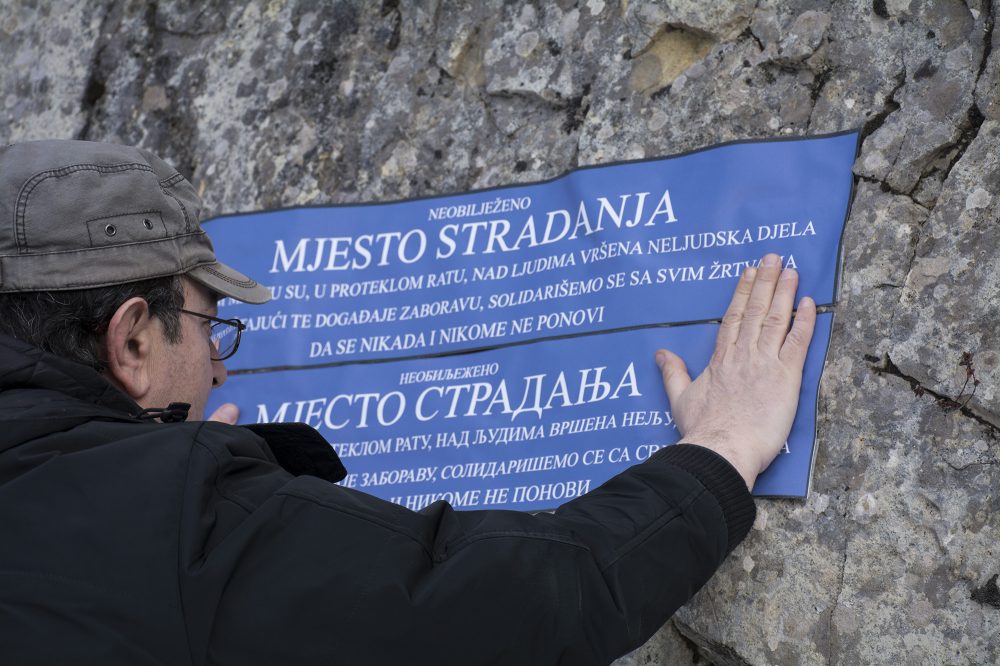Although more than two decades have passed since the war in Bosnia and Herzegovina, many sites of suffering remain unmarked. At the end of March 2018, in our seventh action of marking unmarked sites of suffering, we marked sites of suffering in Vareš, Jajce, Prijedor and at Korićanske stijene.
As an informal group of peace activists, over the past three years we have been raising awareness that numerous buildings (cultural centres, schools, factories, police stations, hotels, etc.) were sites of detention or murder during the war. Following the war, these buildings were mostly renovated and restored to their original use, but they have not been marked as sites of suffering.
In our most recent action, we marked the auxiliary building next to the Police Station in Prijedor, which was used in May 1992 as a site of detention for more than 30 Croats and Bosniaks, but also as a transit centre for prisoners being moved to Omarska and other detention camps. We also marked the Cultural Centre in the village of Miska Glava near Prijedor which was the site of detention of 114 Bosniak civilians in July 1992. On the outskirts of Prijedor, we also marked the football stadium in Ljubija where a large number of Bosniak civilians were transferred from other prison sites and where civilians were abused and beaten daily, and many were killed. In Ljubija, above the mine, in a place called Redak, we marked an unmarked site of suffering where executions were performed and where mass graves were found.
With an appeal to the local authorities of Kneževo (Skender Vakuf) to finally allow the building of a monument to victims, we marked the site of Korićanske stijene, one of the symbols of suffering for people from Prijedor, where 150 Bosniak and Croat civilians were killed in August 1992.

In Bravnice near Jajce, we marked the site of suffering of Serb civilians that were part of a bus convoy. Dozens of people were killed at this site, but no one has yet been prosecuted for this war crime, despite the fact that the Prosecutor’s Office of BiH opened the case more than 10 years ago.
In Vareš-Majdan, we marked the old crafts school where more than 250 Bosniaks were detained in October 1993. Also in Vareš, we marked the “Auto-trans” building where Croat prisoners were detained in 1994, many of them subjected to abuse and forced labour.
From May to June 1993, what used to be the Sretno Motel in Kakanj became a detention facility for Serbs and Croats, and was also marked as a site of suffering during this action.
The aim of our activities is to encourage local communities to properly mark unmarked sites of suffering, thereby paying their respects to the victims and express remorse over the loss of life and human suffering. We believe this would be a step towards a fair attitude towards the past. To date, we have marked 57 sites of suffering throughout BiH.
Unfortunately, in many cases local authorities refuse to allow victims to mark sites of suffering in a dignified manner, especially when the victims belong to today’s “minority” communities in the towns. Illustrative examples of this are Korićanske stijene, as well as other sites of suffering such as Kazani near Sarajevo or the N.K. Iskra stadium in Bugojno.

As members of Bosnian-Herzegovinian society who desire a future free of violence, we call upon local authorities not only to allow victims associations to build monuments, but to initiate activities of marking and commemorating suffering. We believe this would set an example of a fair attitude towards a painful past and would be a significant step in peacebuilding.
A video from our most recent action is available for viewing here: